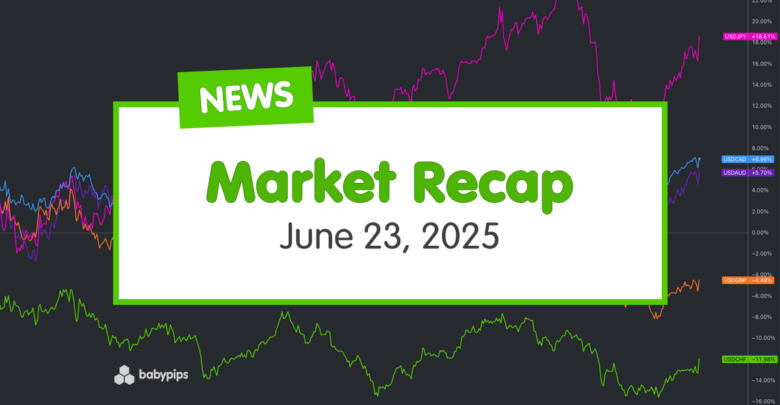Markets kicked the week off on a cautious note after Trump dropped a bombshell (literally) on Iran over the weekend.
Crude oil gapped higher on heightened global supply jitters but soon unwound its gains sharply on reports that Iran refrained from disrupting oil tanker traffic in the Strait of Hormuz.
Here are headlines you may have missed in the last trading sessions!
Headlines:
- U.S. military bombers struck Iran’s three main nuclear sites over the weekend, contrary to earlier plans to delay decision by two weeks
- Australia S&P Global Services PMI Flash for June 2025: 51.3 (50.1 forecast; 50.6 previous)
- Australia S&P Global Manufacturing PMI Flash for June 2025: 51.0 (50.5 forecast; 51.0 previous)
- Japan Jibun Bank Manufacturing PMI Flash for June 2025: 50.4 (49.7 forecast; 49.4 previous)
- Japan Jibun Bank Services PMI Flash for June 2025: 51.5 (51.5 forecast; 51.0 previous)
- Germany HCOB Manufacturing PMI Flash for June 2025: 49.0 (49.1 forecast; 48.3 previous)
- Germany HCOB Services PMI Flash for June 2025: 49.4 (48.0 forecast; 47.1 previous)
- Euro area HCOB Manufacturing PMI Flash for June 2025: 49.4 (49.9 forecast; 49.4 previous)
- Euro area HCOB Services PMI Flash for June 2025: 50.0 (50.1 forecast; 49.7 previous)
- U.K. S&P Global Manufacturing PMI Flash for June 2025: 47.7 (46.6 forecast; 46.4 previous)
- U.K. S&P Global Services PMI Flash for June 2025: 51.3 (51.0 forecast; 50.9 previous)
- Iran retaliated against a U.S. base, although no fatalities were reported
- U.S. S&P Global Services PMI Flash for June 2025: 53.1 (53.0 forecast; 53.7 previous)
- U.S. S&P Global Manufacturing PMI Flash for June 2025: 52.0 (52.0 forecast; 52.0 previous)
- U.S. Existing Home Sales for May 2025: 0.8% m/m to 4.03M (-2.5% m/m forecast; -0.5% m/m previous)
- Iran reportedly refrained from disrupting oil tanker traffic in Strait of Hormuz, as Trump raised hopes of de-escalation
Broad Market Price Action:
All the market attention seemed to be fixed on the geopolitical situation between Israel and Iran, as well as U.S. military engagement, after President Trump gave the green light for military bombers to strike Iranian nuclear facilities over the weekend.
WTI crude oil gapped higher while investors anticipated a potential disruption in oil production and traffic along the Strait of Hormuz, although these fears were erased later in the day, triggering a massive decline for the energy commodity on profit-taking.
Safe-haven gold moved mostly sideways throughout the day but remained elevated during the U.S. session while market participants continued to monitor the situation in the Middle East. Bitcoin, was off to a weak start as it tested the $100K support zone early on, before staging a rebound back to the $104K levels as risk appetite improved towards the end of the trading day.
Meanwhile, the dollar and Treasury yields were also able to benefit from safe-haven flows during the early trading sessions but wound up retreating as the focus turned to potential de-escalation in the Iran conflict.
FX Market Behavior: U.S. Dollar vs. Majors:
It was PMI day in the currency markets, as major economies geared up to report an initial glimpse into manufacturing and services sector activity for June. However, dollar pairs moved mostly in tandem while risk flows stemming from geopolitical tensions remained the major driver of price action.
The U.S. dollar started off on strong footing, as safe-haven flows picked up after weekend reports of the U.S. attack on Iran, which prompted speculations of WWIII. USD sustained its gains versus higher-yielding currencies like AUD and NZD while also advancing against JPY throughout the Asian session and consolidating against CHF, as well as the other European currencies and the oil-related CAD.
Flash PMI readings from the eurozone turned out mixed, with France printing weaker than expected results while Germany had some green shoots but not enough to bring the industries back in expansion. U.K. flash PMI data also reflected improvements but didn’t seem enough to boost GBP against the dollar, as markets remained on edge for potential retaliation from Iran during the London session.
Uncle Sam’s flash PMI figures also had some positive surprises, yet the dollar was unable to extend its climb then as the release coincided with a broad improvement in risk sentiment thanks to reports that Middle East tensions may be starting to de-escalate. By session’s end USD had unwound its safe-haven rallies from earlier in the day, closing in the red across the board.
Upcoming Potential Catalysts on the Economic Calendar
- BOJ core CPI at 5:00 am GMT
- German Ifo business climate index at 8:00 am GMT
- BOE Governor Bailey’s speech at 8:00 am GMT
- BOE MPC member Greene’s speech at 9:30 am GMT
- U.K. CBI industrial order expectations at 10:00 am GMT
- Canada CPI reports at 12:30 pm GMT
- ECB head Lagarde’s speech at 1:00 pm GMT
- U.S. S&P/CS Composite-20 HPI at 1:00 pm GMT
- FOMC member Hammack’s speech at 1:15 pm GMT
- BOE MPC member Ramsden’s speech at 1:35 pm GMT
- BOE Governor Bailey’s speech at 2:00 pm GMT
- FOMC head Powell’s speech at 2:00 pm GMT
- U.S. CB consumer confidence index at 2:00 pm GMT
- U.S. Richmond manufacturing index at 2:00 pm GMT
- BOE MPC member Pill’s speech at 3:40 pm GMT
- BOE MPC member Breeden’s speech at 3:50 pm GMT
- FOMC member Williams’ speech at 4:30 pm GMT
The spotlight could turn back to economic data for today, as Canada is scheduled to print its CPI report while a handful of central bankers are scheduled to give testimonies.
Keep your eyes and ears peeled for remarks highlighting the additional uncertainty stemming from geopolitical tensions, as these could impact their policy outlook. Apart from that, the U.S. CB consumer confidence index could also spur USD volatility since it provides an early look into spending behavior for the current month.
As always, stay nimble and don’t forget to check out our Forex Correlation Calculator when taking any trades!









